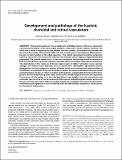| dc.contributor.author | Saint-Geniez, Magali | |
| dc.contributor.author | D'Amore, Patricia Ann | |
| dc.date.accessioned | 2018-02-23T20:51:09Z | |
| dc.date.issued | 2004 | |
| dc.identifier | Quick submit: 2017-06-23T14:37:41-0400 | |
| dc.identifier.citation | Saint-Geniez, Magali, and Patricia A. D’amore. 2004. “Development and Pathology of the Hyaloid, Choroidal and Retinal Vasculature .” The International Journal of Developmental Biology 48 (8-9): 1045–1058. doi:10.1387/ijdb.041895ms. | en_US |
| dc.identifier.issn | 0214-6282 | en_US |
| dc.identifier.uri | http://nrs.harvard.edu/urn-3:HUL.InstRepos:34865269 | |
| dc.description.abstract | During embryogenesis, the development and differentiation of the eye requires the concomitant formation of the neural/glial elements along with a dense vascular network. The adult neural retina is supported by two distinct vascular systems, the proper retinal vessels and the choroidal vessels. The two beds differ not only in their pattern of embryonic differentiation, but also in their function in the adult organism. The retinal vasculature has barrier properties similar to those observed in the brain, whereas the choroidal vessels display a highly fenestrated phenotype. The hyaloid vasculature is a transient embryonic vascular bed which is complete at birth in mammals and regresses contemporaneously with the formation of the retinal vasculature. The dependence of the retina on its blood supply makes it highly vulnerable to any vascular changes and indeed ocular diseases, such as proliferative retinopathy, age-related macular degeneration and the hyperplastic primary vitreous, which are associated with abnormalities of the different vascular beds of the eye. A number of factors have been implicated in developmental and pathological changes in vessel formation and regression, including fibroblast growth factors, platelet-derived endothelial growth factor and vascular endothelial growth factor, among others. The purpose of this review is to describe and discuss new insights into the mechanisms and molecular cues involved in the development of the normal and pathological vascular systems of the eye. The characterization of the molecules and cell-cell interactions involved in the formation, stabilization and regression of new vessels has led to the identification of potential control points for therapeutic intervention. | en_US |
| dc.language.iso | en_US | en_US |
| dc.publisher | UPV/EHU Press | en_US |
| dc.relation.isversionof | 10.1387/ijdb.041895ms | en_US |
| dash.license | LAA | |
| dc.subject | angiogenesis | en_US |
| dc.subject | vascularization | en_US |
| dc.subject | retinopathy of prematurity | en_US |
| dc.subject | diabetic retinopathy | en_US |
| dc.title | Development and pathology of the hyaloid, choroidal and retinal vasculature | en_US |
| dc.type | Journal Article | en_US |
| dc.date.updated | 2017-06-23T18:37:44Z | |
| dc.description.version | Version of Record | en_US |
| dc.relation.journal | The International Journal of Developmental Biology | en_US |
| dash.depositing.author | D'Amore, Patricia Ann | |
| dc.date.available | 2004 | |
| dc.date.available | 2018-02-23T20:51:09Z | |
| dc.identifier.doi | 10.1387/ijdb.041895ms | * |
| workflow.legacycomments | cat.complete | en_US |
| dash.authorsordered | false | |
| dash.contributor.affiliated | D'Amore, Patricia | |
| dash.contributor.affiliated | Saint-Geniez, Magali | |


